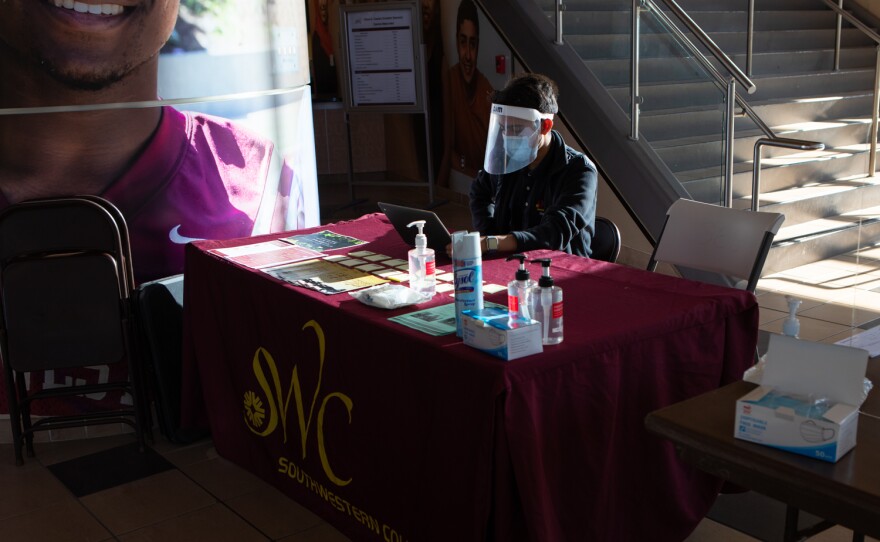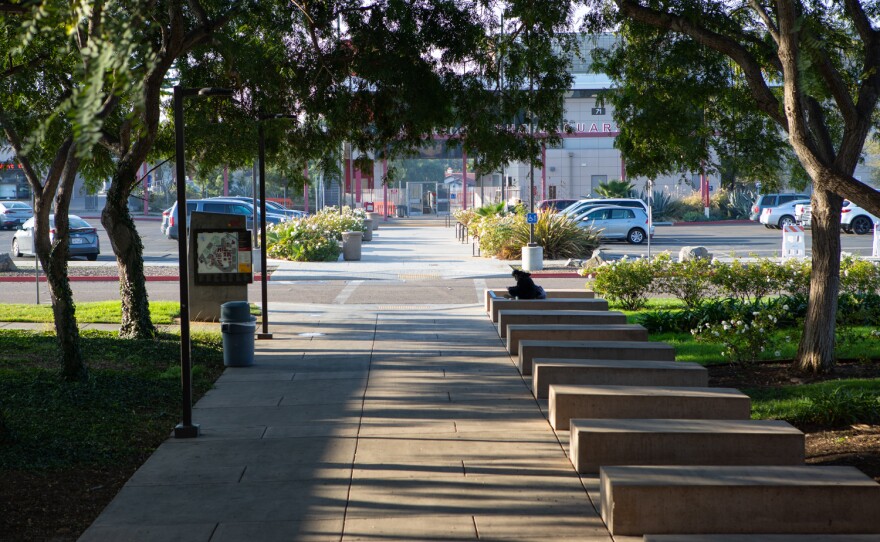Enrollment at community colleges across the U.S. surged more than a decade ago, as people flocked to campuses for new skills amid the Great Recession’s brutal job market.
So when COVID-19 hit, community colleges again anticipated an influx of students. Another economic downturn and the Great Resignation — the term coined to describe the record number of people leaving their jobs during the pandemic — had arrived.
But this time, the students haven’t.
San Diego County’s community colleges saw a 12% drop in their student headcount during the first full academic year since COVID-19 first shut down businesses and schools. That’s nearly 30,000 fewer students, according to data from the California Community Colleges System.
Like statewide trends, the sharpest declines are among older attendees. Together, the nine colleges in the county saw a more than 40% decrease among students 50 and older. Students of color also recorded bigger drops than their white counterparts.
Five colleges suffered double-digit percentage drops. State data shows the biggest decline was at the San Diego College of Continuing Education, California’s largest provider of noncredit courses.
School officials told inewsource their nontraditional programs — with many coming and going throughout the year — make it difficult to accurately track the true number of enrolled students. But the college’s headcount dropped by 38%, according to state numbers.
The college offers a wide array of services to adults seeking additional training or education, including programs for immigrants and English as a second language learners. Many of its programs are already geared toward serving some of the county’s most disadvantaged students — the least likely to return during the pandemic.
Fewer enrollees aren’t an anomaly, said Southwestern College President Mark Sanchez: Students have more choices for their education. He pointed to for-profit colleges, where degrees can be obtained in less time.

Sanchez said community colleges need to offer quicker options and provide students with additional resources beyond the classroom. If the colleges don’t, he said, “we will become obsolete.”
“We need to get away from thinking that the way we’re doing business is OK and we’re gonna survive,” Sanchez said. “We’re not.”
Most vulnerable, least likely to return
A cheaper path to a degree, community colleges offer educational and technical programs that train nurses, firefighters, police officers and more.
They’re also vital for marginalized communities: Community colleges serve a larger share of people of color than four-year institutions, and their students have higher rates of homelessness and food insecurity.
Nationwide, nearly 30% of community college attendees are part of the first generation in their family to attend college. Twenty percent of students have disabilities. Fifteen percent are single parents.
Some colleges already were facing financial trouble before COVID-19, though having fewer students isn’t expected to substantially hurt their bottom lines. The state’s next budget is expected to again use pre-pandemic enrollment to determine funding.
Yet community colleges have long advocated for more funding as K-12 and four-year institutions receive substantially more state money on a per-student basis. The University of California system receives almost $32,000 per student, compared to community colleges getting about $9,500.
“Yet we’re asked to serve the students with the most challenges,” said Carlos Turner Cortez, chancellor of the San Diego Community College District. “To me, that seems antithetical.”
College officials say for some, the pandemic exacerbated existing problems. Students of color, single parents and older attendees make up large shares of enrollment drops, they said.
Southwestern’s Sanchez said community colleges can be “the great equalizer,” offering a pathway to a living-wage career.
“But we also know that if education is not done the right way, if it’s not set up the right way,” he said, “we can actually exacerbate that issue by having people start their goal but not finish, lose their trajectory.”
Locally, double-digit percentage drops were recorded last school year among Black students (nearly 16%); Pacific Islander students (almost 20%); Asian students (close to 18%); and Hispanics and Latinos (nearly 14%), who make up the largest group of students.
White and Filipino students had smaller declines, with each group showing close to a 10% drop. The number of students who identify as more than one ethnicity was largely unchanged.
At the College of Continuing Education, where none of its programs were fully available online prior to the pandemic, beginning-level ESL students were among the most likely to leave.
“The biggest piece was really, our lower-level students — to engage through the technology and remotely, was just so, so difficult,” said Michelle Fischthal, the college’s vice president of instructional services.
Southwestern battles pandemic, image problem
A group project for Ivan Luna’s only in-person class last semester — an exercise science course that focused on teaching physical education to elementary school kids — would have been difficult to do over Zoom.
The class of about a dozen students took to Southwestern’s football field, where the group simulated exercises meant for kids no older than second-graders. Luna and two other students designed their own lesson, complete with hula hoops, cones and bean bags.
In so-called normal times, the class would have partnered with a nearby elementary school. Because of COVID-19, his classmates had to fill the role.

Luna, 18, said the transition to remote learning wasn’t difficult. He took online classes to graduate high school early. Southwestern helped with any other challenges: After the pandemic hit, the college gave his brother and fellow student a laptop to continue his courses.
When the siblings do need to attend in person, they’re experiencing a different campus.
“I used to come here Mondays and Wednesdays before the pandemic,” Luna said. “And I would see a lot of students all around the college. It was like 2:50 and there was a bunch of students everywhere.
“Right now,” he said while walking through the heart of the campus, “it’s 1:40 and it’s empty.”
Like the county’s other community colleges, Southwestern tried to meet students’ needs during the pandemic, such as hosting food distribution, offering mental health services and dispersing laptops and WiFi hotspots.
The college’s headcount dropped nearly 14% after COVID-19, losing nearly 4,000 students. Its headcount for students 50 and older slashed by half.
Sanchez, a Southwestern alum himself who has held the college’s top role for nearly a year, said the pandemic joined an already existing issue — the college’s reputation problem. Racial tensions at the college have persisted in recent years, with a 2018 report by University of Southern California researchers concluding Southwestern had “a palpable climate of anti-blackness.”
Five staffers also sued the college in November 2020 alleging racial discrimination. A jury trial is set for September.
Sanchez’s predecessor, Kindred Murillo, led several efforts to help address the problems, including additional training, surveying students and employees for their perspectives on the college’s racial tensions and creating an Office of Equity and Engagement.
Sanchez said the college now has a comprehensive marketing campaign.

“Allied health, fire, EMT, business, child development or teaching — all of the programs that we’ve put in place have been deemed pandemic-proof,” he said. “In other words, there are job opportunities in those sectors even with the pandemic. So we’re marketing that.”
He added, “We have all of the supports and resources you need to bring you back into the institution.”
Helping students beyond the classroom
Cortez, the San Diego district’s chancellor, believes enrollment will come back strong, and other community college leaders say they’re already seeing some progress.
At the beginning of last semester, Southwestern College faced a 30% decline that Sanchez says officials managed to narrow to 7% by December. The College of Continuing Education also met its most recent enrollment targets, Fischthal said, as officials continue to expand online options.
“So although we have had this decrease in enrollment, I really believe we’ve been able to keep up the quality,” she said.
The San Diego Community College District, which serves almost 100,000 students across four colleges, in general fared slightly better than others in the county. City College in downtown San Diego actually saw a 5% increase in students.
Cortez credits the district’s work in addressing students’ needs before the pandemic. He said marketing — and funding — will be key to attracting students.
“The reality is, we’ve been built to fail in many ways,” the chancellor said, referring to community college funding, “until we recognize the value of these institutions in preparing students for the workforce, particularly in career education and for transferring.
“The investment needs to be increased.”

Now, several community colleges are turning to housing. Cortez said his district is undergoing strategic planning on dormitories and anticipates breaking ground within the next couple years.
Sanchez said Southwestern has applied for grant funding after the state allocated more than $1 billion for colleges interested in building student housing. Southwestern’s proposal includes a “continuum of support,” he said, with other developments that offer needed resources for students but also generate revenue for the college.
“Is the (housing) issue gonna get any better in San Diego County? The resounding answer to that is no,” Sanchez said.
“So we have to create solutions that will allow us to deliver that critical support while also bringing people into education, career development, personal goal development. And I really believe that’s the future of Southwestern College.”
Southwestern expects to soon have 60% of its classes in person, though the latest wave of COVID-19 cases has forced community colleges to move to remote operations ahead of the spring semester.







